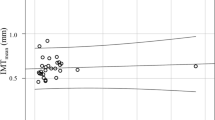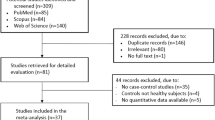Abstract
Systemic sclerosis (SSc) is a kind of autoimmune disease characterized by inflammatory and endothelial dysfunction. Asymmetric dimethylarginine (ADMA), as an endogenous nitric oxide synthase inhibitor, can cause or contribute to the inflammatory syndrome and endothelial dysfunction. Recently, increased ADMA levels have been demonstrated in SSc, revealing that ADMA might play an important role for the associated manifestations of SSc. Besides, ADMA may play a significant role in the level of NO, which is produced by arginine. In the review, we discuss the role of arginine and ADMA in patients with SSc.

Similar content being viewed by others
References
Sgonc, R., M.S. Gruschwitz, G. Boeck, N. Sepp, J. Gruber, and G. Wick. 2000. Endothelial cell apoptosis in systemic sclerosis is induced by antibody-dependent cell-mediated cytotoxicity via CD95. Arthritis and Rheumatism 43: 2550–2562.
Herrick, A.L. 2005. Pathogenesis of Raynaud’s phenomenon. Rheumatology (Oxford, England) 44: 587–596.
Kahaleh, M.B. 1991. Endothelin, an endothelial-dependent vasoconstrictor in scleroderma. Enhanced production and profibrotic action. Arthritis and Rheumatism 34: 978–983.
Denton, C.P., M.C. Bickerstaff, X. Shiwen, M.T. Carulli, D.O. Haskard, R.M. Dubois, and C.M. Black. 1995. Serial circulating adhesion molecule levels reflect disease severity in systemic sclerosis. British Journal of Rheumatology 34: 1048–1054.
Pignone, A., C. Scaletti, M. Matucci-Cerinic, D. Vazquez-Abad, P.L. Meroni, N. Del Papa, F. Falcini, S. Generini, N. Rothfield, and M. Cagnoni. 1998. Anti-endothelial cell antibodies in systemic sclerosis: Significant association with vascular involvement and alveolo-capillary impairment. Clinical and Experimental Rheumatology 16: 527–532.
Kahaleh, B., P. Fan, M. Matucci-Cerinic, M. Stefanovic-Racic, and L. Ignarro. 1993. Study of endothelial dependent relaxation in scleroderma. Arthritis and Rheumatism 36: S180.
Kahaleh, B., and P. Fan. 1998. Down regulation of nitric oxide synthase gene in microvascular endothelial cells from lesional scleroderma: Assessment by quantitative RT-PCR and possible role for cytotoxic T-cells. Arthritis and Rheumatism 41: S277.
Yamamoto, T., I. Katayama, and K. Nishioka. 1998. Nitric oxide production and inducible nitric oxide synthase expression in systemic sclerosis. The Journal of Rheumatology 25: 314–317.
Cotton, S.A., A.L. Herrick, M.I. Jayson, and A.J. Freemont. 1999. Endothelial expression of nitric oxide synthases and nitrotyrosine in systemic sclerosis skin. The Journal of Pathology 189: 273–278.
Andersen, G.N., K. Caidahl, E. Kazzam, A.S. Petersson, A. Waldenstrom, L. Mincheva-Nilsson, and S. Rantapaa-Dahlqvist. 2000. Correlation between increased nitric oxide production and markers of endothelial activation in systemic sclerosis: Findings with the soluble adhesion molecules E-selectin, intercellular adhesion molecule 1, and vascular cell adhesion molecule 1. Arthritis and Rheumatism 43: 1085–1093.
Boger, R.H., S.M. Bode-Boger, W. Thiele, W. Junker, K. Alexander, and J.C. Frolich. 1997. Biochemical evidence for impaired nitric oxide synthesis in patients with peripheral arterial occlusive disease. Circulation 95: 2068–2074.
Cals-Grierson, M.M., and A.D. Ormerod. 2004. Nitric oxide function in the skin. Nitric Oxide: Biology and Chemistry/Official Journal of the Nitric Oxide Society 10: 179–193.
Clancy, R.M., A.R. Amin, and S.B. Abramson. 1998. The role of nitric oxide in inflammation and immunity. Arthritis and Rheumatism 41: 1141–1151.
Matucci Cerinic, M., and M.B. Kahaleh. 2002. Beauty and the beast. The nitric oxide paradox in systemic sclerosis. Rheumatology (Oxford, England) 41: 843–847.
Boger, R.H., P. Vallance, and J.P. Cooke. 2003. Asymmetric dimethylarginine (ADMA): A key regulator of nitric oxide synthase. Atherosclerosis Supplements 4: 1–3.
Vallance, P., and J. Leiper. 2004. Cardiovascular biology of the asymmetric dimethylarginine: Dimethylarginine dimethylaminohydrolase pathway. Arteriosclerosis, Thrombosis, and Vascular Biology 24: 1023–1030.
Rajagopalan, S., D. Pfenninger, C. Kehrer, A. Chakrabarti, E. Somers, R. Pavlic, D. Mukherjee, R. Brook, L.G. D’Alecy, and M.J. Kaplan. 2003. Increased asymmetric dimethylarginine and endothelin 1 levels in secondary Raynaud's phenomenon: Implications for vascular dysfunction and progression of disease. Arthritis and Rheumatism 48: 1992–2000.
Landar, A., and V.M. Darley-Usmar. 2003. Nitric oxide and cell signaling: Modulation of redox tone and protein modification. Amino Acids 25: 313–321.
Patel, R.P., A. Levonen, J.H. Crawford, and V.M. Darley-Usmar. 2000. Mechanisms of the pro- and anti-oxidant actions of nitric oxide in atherosclerosis. Cardiovascular Research 47: 465–474.
Dooley, A., B. Gao, N. Bradley, D.J. Abraham, C.M. Black, M. Jacobs, and K.R. Bruckdorfer. 2006. Abnormal nitric oxide metabolism in systemic sclerosis: Increased levels of nitrated proteins and asymmetric dimethylarginine. Rheumatology (Oxford, England) 45: 676–684.
Takagi, K., Y. Kawaguchi, M. Hara, T. Sugiura, M. Harigai, and N. Kamatani. 2003. Serum nitric oxide (NO) levels in systemic sclerosis patients: Correlation between NO levels and clinical features. Clinical and Experimental Immunology 134: 538–544.
Romero, L.I., D.N. Zhang, J.P. Cooke, H.K. Ho, E. Avalos, R. Herrera, and G.S. Herron. 2000. Differential expression of nitric oxide by dermal microvascular endothelial cells from patients with scleroderma. Vascular Medicine (London, England) 5: 147–158.
Freedman, R.R., R. Girgis, and M.D. Mayes. 1999. Endothelial and adrenergic dysfunction in Raynaud’s phenomenon and scleroderma. The Journal of Rheumatology 26: 2386–2388.
Kooy, N.W., J.A. Royall, Y.Z. Ye, D.R. Kelly, and J.S. Beckman. 1995. Evidence for in vivo peroxynitrite production in human acute lung injury. American Journal of Respiratory and Critical Care Medicine 151: 1250–1254.
Agostoni, A., B. Marasini, M.L. Biondi, C. Bassani, A. Cazzaniga, B. Bottasso, and M. Cugno. 1991. L-arginine therapy in Raynaud’s phenomenon? International Journal of Clinical & Laboratory Research 21: 202–203.
Freedman, R.R., R. Girgis, and M.D. Mayes. 1999. Acute effect of nitric oxide on Raynaud’s phenomenon in scleroderma. Lancet 354: 739.
Giuggioli, D., M. Colaci, M. Sebastiani, and C. Ferri. 2010. L-Arginine in pregnant scleroderma patients. Clinical Rheumatology 29: 937–939.
Dimitroulas, T., G. Giannakoulas, K. Papadopoulou, H. Karvounis, H. Dimitroula, G. Koliakos, T. Karamitsos, D. Parcharidou, and L. Settas. 2010. Early detection of cardiac involvement in systemic sclerosis assessed by tissue-Doppler echocardiography: Relationship with neurohormonal activation and endothelial dysfunction. The Journal of Rheumatology 37: 993–999.
Ciurzynski, M., P. Bienias, K. Irzyk, M. Kostrubiec, Z. Bartoszewicz, M. Siwicka, A. Stelmaszczyk-Emmel, E. Gorska, U. Demkow, and P. Pruszczyk. 2014. Serum endothelin-1 and NT-proBNP, but not ADMA, endoglin and TIMP-1 levels, reflect impaired right ventricular function in patients with systemic sclerosis. Clinical Rheumatology 33: 83–89.
Blaise, S., R. Maas, C. Trocme, G.D. Kom, M. Roustit, P.H. Carpentier, and J.L. Cracowski. 2009. Correlation of biomarkers of endothelium dysfunction and matrix remodeling in patients with systemic sclerosis. The Journal of Rheumatology 36: 984–988.
Turiel, M., L. Gianturco, C. Ricci, P. Sarzi-Puttini, L. Tomasoni, G. Colonna Vde, P. Ferrario, O. Epis, and F. Atzeni. 2013. Silent cardiovascular involvement in patients with diffuse systemic sclerosis: A controlled cross-sectional study. Arthritis Care & Research 65: 274–280.
Dimitroulas, T., G. Giannakoulas, K. Papadopoulou, T. Sfetsios, H. Karvounis, H. Dimitroula, D. Parcharidou, G. Koliakos, A. Garyfallos, I. Styliadis, et al. 2010. Left atrial volume and N-terminal pro-B type natriuretic peptide are associated with elevated pulmonary artery pressure in patients with systemic sclerosis. Clinical Rheumatology 29: 957–964.
Dimitroulas, T., G. Giannakoulas, T. Sfetsios, H. Karvounis, H. Dimitroula, G. Koliakos, and L. Settas. 2008. Asymmetrical dimethylarginine in systemic sclerosis-related pulmonary arterial hypertension. Rheumatology (Oxford, England) 47: 1682–1685.
Wipff, J., J. Avouac, D. Borderie, D. Zerkak, H. Lemarechal, A. Kahan, C. Boileau, and Y. Allanore. 2008. Disturbed angiogenesis in systemic sclerosis: High levels of soluble endoglin. Rheumatology (Oxford, England) 47: 972–975.
Moncada, S., R.M. Palmer, and E.A. Higgs. 1991. Nitric oxide: Physiology, pathophysiology, and pharmacology. Pharmacological Reviews 43: 109–142.
Giaid, A., and D. Saleh. 1995. Reduced expression of endothelial nitric oxide synthase in the lungs of patients with pulmonary hypertension. The New England Journal of Medicine 27: 214–221.
Tomita, H., K. Egashira, Y. Ohara, M. Takemoto, M. Koyanagi, M. Katoh, H. Yamamoto, K. Tamaki, H. Shimokawa, and A. Takeshita. 1998. Early induction of transforming growth factor-beta via angiotensin II type 1 receptors contributes to cardiac fibrosis induced by long-term blockade of nitric oxide synthesis in rats. Hypertension 32: 273–279.
Leiper, J., J. Murray-Rust, N. McDonald, and P. Vallance. 2002. S-nitrosylation of dimethylarginine dimethylaminohydrolase regulates enzyme activity: Further interactions between nitric oxide synthase and dimethylarginine dimethylaminohydrolase. Proceedings of the National Academy of Sciences of the United States of America 99: 13527–13532.
Kahaleh, M.B., and P.S. Fan. 1997. Mechanism of serum-mediated endothelial injury in scleroderma: Identification of a granular enzyme in scleroderma skin and sera. Clinical Immunology and Immunopathology 83: 32–40.
Drenk, F., and H.R. Deicher. 1988. Pathophysiological effects of endothelial cytotoxic activity derived from sera of patients with progressive systemic sclerosis. The Journal of Rheumatology 15: 468–474.
Acknowledgments
This work was partly supported by grants from the Key Project of the Education Department of Anhui Province Natural Science Research (code: KJ2012A165, KJ2014A127) and Anhui Provincial Natural Science Foundation (code: 1308085MH169).
Conflict of Interest
None.
Author information
Authors and Affiliations
Corresponding author
Additional information
Li Zhang and Ya-Nan Wan contributed equally to this work and acted as co-first authors.
Rights and permissions
About this article
Cite this article
Zhang, L., Wan, YN., Zhao, JH. et al. The Association Between Systemic Sclerosis, Arginine and Asymmetric Dimethylarginine. Inflammation 38, 218–223 (2015). https://doi.org/10.1007/s10753-014-0025-9
Published:
Issue Date:
DOI: https://doi.org/10.1007/s10753-014-0025-9




